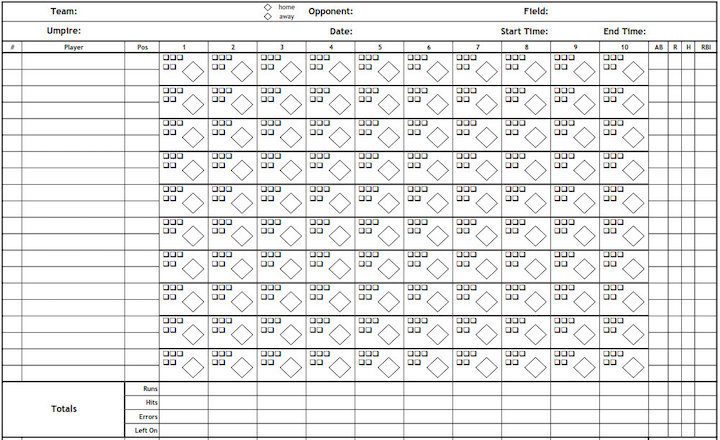If you have intentions of being involved in baseball for many years, it's important to learn how to keep score in baseball.
This method is used across the board so that anyone can understand what happened on every play in the game, no matter whether they attended the game or even watched the game at all.
Unlike some other sports, though, keeping score in baseball can seem like a daunting task. That's because not only is every play in a game tracked, but so, too, is every pitch.
Once you learn how to keep score in baseball, though, doing so is a breeze and is actually quite fun.
Let's take a look at all the aspects of keeping score in a baseball game.
What a Baseball Scorecard Looks Like:

Image Credit - www.yourprintablepdf.com
A baseball scorecard will be presented in a landscape format, with columns for each batter in the lineup and rows for each inning of the game.
On the left side is where each hitter and his position will be listed, in the batting order.
There is then a corresponding box in each row to the right of the names that represent each inning.
When you keep score in a baseball game, you will record what happened with each batter in the appropriate box.
For example, to start off, you'll be recording the outcome of the play for the leadoff hitter in the box that corresponds to the first inning.
You will be recording balls and strikes as well as the outcome of the actual at bat -- whether it was a hit, a walk, an out or a strikeout, for example.

How the Positions are Represented
To make things easier to track, each position on the field is represented by a number.
This will make it simpler for you to track the play.
The positions are as follows...
1: Pitcher
2: Catcher
3: First Base
4: Second Base
5: Third Base
6: Shortstop
7: Left Field
8: Center Field
9: Right Field
How to Track Plate Appearances
Like the positions, each plate appearance -- in which the batter either reaches base safely or makes an out -- is tracked with certain abbreviations.
These include...
1B: Single
2B: Double
3B: Triple
HR: Home Run
BB: Walk
I: Interference
HBP: Hit by Pitch
E: Error
F: Fly Out
f: Foul Out
FC: Fielder's Choice
SAC: Sacrifice Fly or Sacrifice Bunt
K: Strikeout Swinging
KC (or a backwards K): Strikeout Looking
Once the outcome of the at bat is completed, you will record what happened this way.
If the batter reached base safely, for example, by hitting a double, then you will put 2B in the box.
Outs that are recorded will be marked in the box accordingly as well, and also signify which fielder recorded the out.
If it is a Fly Out to center field, for example, you will write F-8.
For ground outs, you will record the play by writing the player who fielded the ball followed by the player who caught the ball for the out.
You will not need a special abbreviation, as listed above.
For example, a ground out fielded by the third baseman and thrown to the first baseman will be recorded in the scorebook as 5-3.
You will also record all outs in the box that corresponds to the batter that made the out.
You will do this by writing the number of the out that was made -- for example 1 for the first out recorded in the inning -- and then circling it.
As the at bat is progressing, there will be balls and strikes recorded.
On the scorebook, there will be a place in each box to push hash marks or check marks -- three for balls and two for strikes.
You should record each as they happen.
This will give you an insight as to what the count was when a certain event in the game happened, and also allow you to track how many pitches each pitcher has thrown.

How to Track Runners' Progression
The final major thing you'll record when learning how to keep score in baseball is how the runners progress around the base path.
In each box will be a diamond that will represent the diamond on the field.
As a runner advances from one base to the next, you will draw a line from the original base and to the end base.
For example, if a hitter gets walked, you will write BB in the box and also draw a line from home plate to first base.
As the runner progresses around the diamond, you will also record how he did so.
Sometimes, the runner will progress from one base to the next based on what a subsequent hitter does.
In this case, you will not need to make a special record of what caused him to advance.
For example, if a runner was on first but moved to second because of a single from the next batter, that will be signified by the 1B you'll put in the next batter's box.
Sometimes, though, the batter will advance from one base to the next based on something other than what the batter does.
These events you will record in the runner's box between the lines you draw between the bases.
These events include:
BK: Balk
PB: Passed Ball
WP: Wild Pitch
SB: Stolen Base
A runner may also make an out on his own, such as when he is caught stealing. That will be signified by a CS.
You will continue to record the progression from each base to the next as the runner progresses around the diamond.
If the runner ends up crossing home plate, you will then shade in the diamond, which will represent that a run has been scored.
Conclusion
There are a lot of things that are involved when learning how to keep score in a baseball game.
While there is certainly a lot to remember and a lot to keep track of, it's actually a simple and fun thing to do once you've understood all the different things you need to track and how to track them.
Keeping score in baseball can actually help you understand how the game is played better, too, so it's a great skill to learn as you're just starting to learn the game of baseball.

